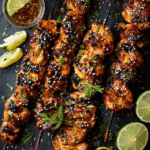Luncheon Meat Musubi is a beloved Hawaiian snack that blends the savory, salty flavors of grilled luncheon meat with slightly sweet soy sauce glaze, all nestled atop a compact block of steamed rice and wrapped with a strip of nori seaweed. Inspired by Japanese onigiri and introduced by Japanese immigrants in Hawaii, this portable, flavorful treat has become a local staple enjoyed at picnics, convenience stores, and family gatherings.
FULL RECIPE
Ingredients
- 2 cups cooked Japanese short-grain rice (preferably sushi rice)
- 1 can (12 oz) luncheon meat (such as Spam), sliced into 8-10 pieces
- 3 tablespoons soy sauce
- 2 tablespoons sugar
- 1 tablespoon mirin (optional)
- 4-5 sheets nori seaweed, cut into 1.5-inch wide strips
- 1 tablespoon vegetable oil
Directions
- Cook the rice according to package instructions and keep it warm.
- Heat vegetable oil in a skillet over medium heat. Fry luncheon meat slices until golden brown on both sides, about 2-3 minutes per side.
- In a small bowl, mix soy sauce, sugar, and mirin until sugar dissolves.
- Pour the sauce over the fried luncheon meat slices in the skillet. Let it cook for another 1-2 minutes, turning the slices to coat them evenly until the sauce thickens slightly and caramelizes. Remove from heat.
- Using a musubi mold or your hands, shape about 1/3 cup of warm rice into a compact rectangular block.
- Place a slice of glazed luncheon meat on top of the rice block.
- Wrap a strip of nori around the musubi, sealing the ends under the rice to hold everything together. The nori can be slightly moistened for better adhesion.
- Repeat the process for the remaining rice and luncheon meat slices.
- Serve musubi warm or at room temperature.
Nutrition Facts
- Calories: 300 kcal
- Protein: 9g
- Carbohydrates: 40g
- Sugars: 6g
- Fat: 9g
- Saturated Fat: 3g
- Fiber: 1g
- Sodium: 750mg
- Cholesterol: 30mg
Origins and Cultural Significance
Luncheon Meat Musubi is a classic Hawaiian snack that reflects the unique cultural blend found in the islands. Its roots trace back to Japanese immigrants who introduced onigiri to Hawaii, which was adapted to incorporate locally available luncheon meat, especially Spam. This fusion created a portable, flavorful dish that became a staple across the islands. Musubi is deeply ingrained in Hawaiian culture, often enjoyed at picnics, school lunches, and family gatherings, symbolizing both convenience and comfort.
Key Ingredients and Their Roles
The main ingredients—luncheon meat, rice, soy sauce, and nori—work harmoniously to create musubi’s signature taste and texture. The luncheon meat provides a salty, savory base with a satisfying meaty bite, while the sushi rice adds a slightly sticky, soft element that holds the shape well. Soy sauce and sugar create a sweet-savory glaze that enhances flavor and caramelizes when cooked. Nori wraps everything together, adding a subtle seaweed flavor and convenient handle for eating.
Flavor Profile
The flavor of luncheon meat musubi is a perfect balance of salty, sweet, and umami. The saltiness comes from the luncheon meat and soy sauce, while the sugar in the glaze adds a delicate sweetness that prevents the dish from feeling overly salty. The rich umami flavor is boosted by the caramelized glaze on the meat. Together with the mild, slightly tangy sushi rice and the crisp nori, every bite is layered with complementary flavors.
Texture and Mouthfeel
Texture plays a critical role in the enjoyment of musubi. The crispy edges of fried luncheon meat contrast with the tender, sticky rice beneath it. The nori wrap adds a slight chewiness and a subtle crisp texture that helps hold the musubi together. This interplay of crunchy, soft, and chewy elements makes musubi both satisfying and easy to eat on the go.
Health Considerations
While luncheon meat musubi is delicious and filling, it’s important to be mindful of its nutritional aspects. Luncheon meat is high in sodium and saturated fats, which can impact heart health if consumed excessively. The sushi rice contributes carbohydrates that provide energy, but the dish can be calorie-dense. For those watching sodium or fat intake, enjoying musubi occasionally as part of a balanced diet is advisable.
Variations and Adaptations
Musubi is highly versatile and can be customized to suit various tastes and dietary preferences. Some variations include using different types of luncheon meat such as turkey or chicken Spam for a leaner option. Vegetarian musubi can substitute grilled tofu or mushrooms. Additionally, experimenting with different sauces like teriyaki or spicy mayo adds new flavor dimensions. Some people also add scrambled eggs or pickled vegetables inside the musubi for extra texture and flavor.
Serving Suggestions
Luncheon meat musubi is best served warm or at room temperature, making it perfect for packed lunches, picnics, or quick snacks. It pairs wonderfully with light sides such as seaweed salad, pickled ginger, or a fresh cucumber salad to balance the richness. It’s also a popular item at Hawaiian luaus and casual gatherings, where it can be served alongside grilled meats or tropical fruit platters.
Storage and Shelf Life
Musubi can be stored in an airtight container in the refrigerator for up to two days, though the nori may lose its crispness over time and become chewy or soggy. For best texture, it’s recommended to wrap musubi individually in plastic wrap and reheat lightly before eating. Freezing is generally not advised, as it affects the texture of the rice and luncheon meat.
Tips for Perfect Musubi
To make the best musubi, it’s important to use freshly cooked sushi rice that is still warm and sticky, as this helps the musubi hold its shape. Cooking the luncheon meat until it is nicely caramelized adds depth of flavor. Using a musubi mold can ensure uniform size and shape, but hand shaping is also traditional and effective. Slightly moistening the edges of the nori helps seal the wrap without tearing.
Advertisement
Popularity and Modern Influence
Musubi’s popularity has grown beyond Hawaii, appearing in food trucks and Asian fusion restaurants worldwide. It represents an approachable way to enjoy Hawaiian flavors and has sparked creative spins on the classic recipe. Its portability and satisfying taste make it a favorite for lunchboxes and casual meals, showcasing the continued evolution of traditional dishes in contemporary culinary scenes.
Conclusion
Luncheon Meat Musubi is a delicious and culturally rich snack that beautifully blends sweet, salty, and savory flavors with satisfying textures. Its simplicity, portability, and deep roots in Hawaiian culture make it a beloved treat for many. Whether enjoyed as a quick bite or part of a larger meal, musubi offers a taste of the islands’ diverse culinary heritage and continues to inspire new variations worldwide.






